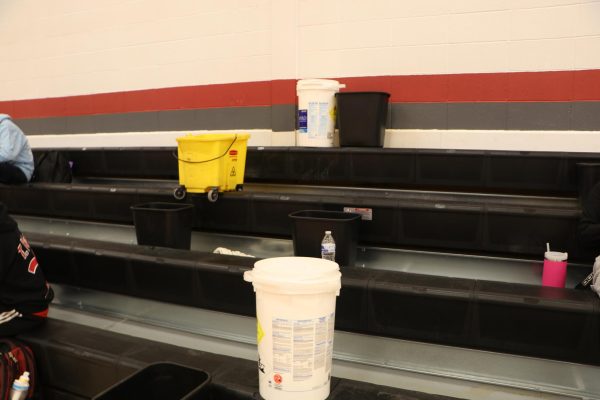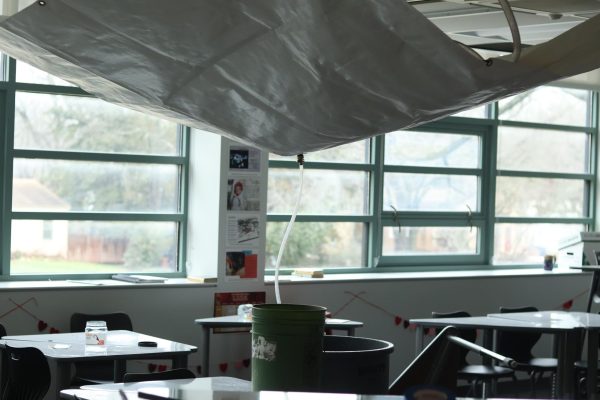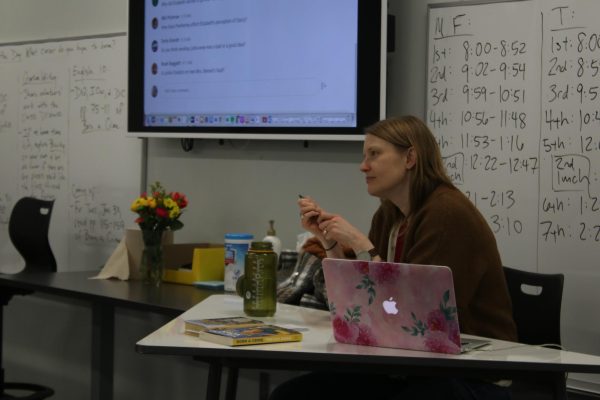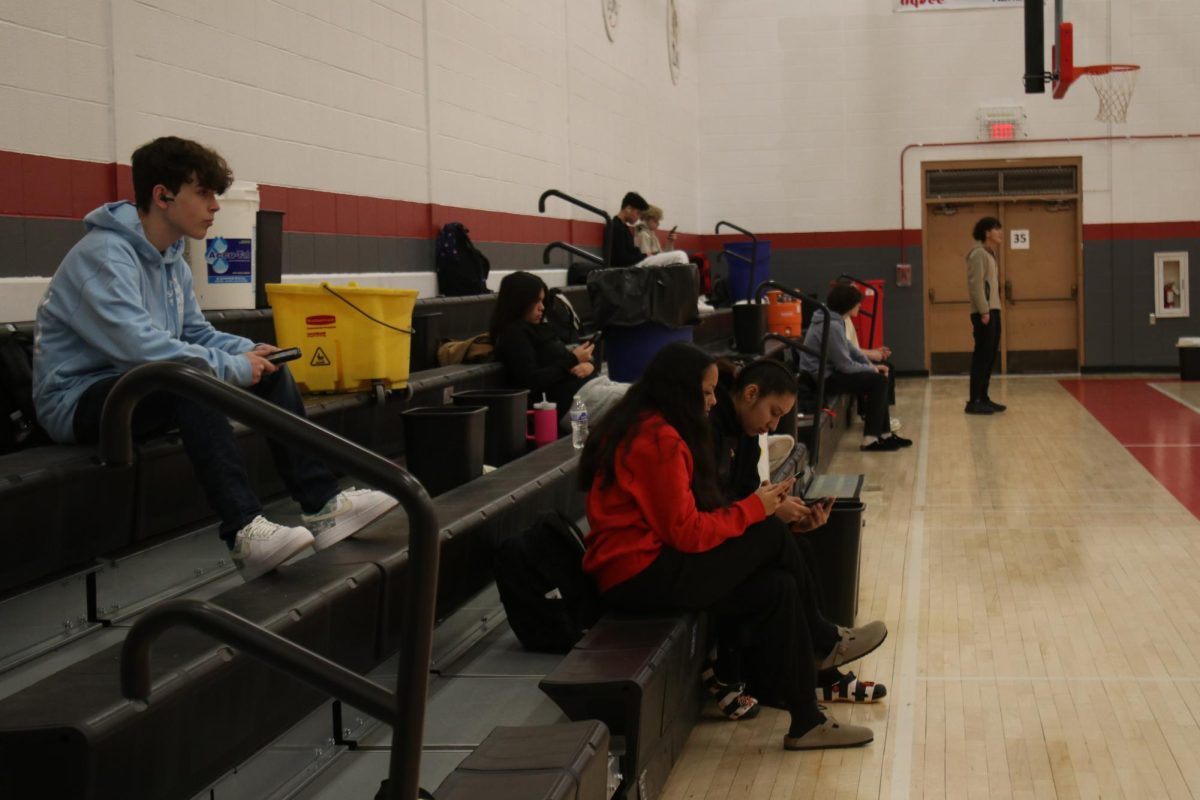Right after teachers finished adjusting their class schedules following four snow days in short succession, the roof came down on them. Literally.
So far this year, a series of compounding ceiling leaks have been plaguing the West Gym, hallways, and one mysteriously concealed learning pod. But the area taking the worst of the damage has been second-floor classrooms. While students may have taken notice of buckets and bins scattered about the building since its remodel, the issue was exacerbated after January’s nearly consecutive streak of inclement weather days.

This breaking point is especially apparent in English teacher Melissa Johnson’s classroom, which is currently inhabited by nothing but a ceiling-sized tarp, funneling the continuous flow of sludge into a container in the center of the room. Johnson’s classes are now held in a previously vacant first-floor classroom. The transition was sudden, but Johnson had seen it coming, having witnessed and reported the more minor leaks for months.
“It was worse than it had ever been, it was just everywhere and it was coming through the walls this time too, it was just awful,” Johnson said. “So basically, I sent an email to all the usual people that I’ve been emailing for 10 months, but this time I wrote ‘emergency’ in the subject and everyone came running, which was very nice.”
Johnson’s history of consistent grievances stretches all the way back to March 2023, far before the inconvenience of a leaky roof reached such a severe level.
“It started small, it was just a little drip in a corner tile, and we got a bucket,” Johnson said. “I started sending emails and asking if this could be fixed all the way back then.”
Although the problem initially lacked administrative attention, the ceiling leaks proved to be a distraction for some students. Students frequently pointed out the pre-existing damage, or complained that the issue was detrimental to the classroom’s ‘vibes.’ They were all but oblivious to the constantly dripping ceiling, despite Johnson’s efforts to maintain the cozy, conversational environment that she and her classes cherish.

English teacher Leah Henry had similar complaints, describing constant contact with LHS Facilities staff and occasional visits from USD 497 Facilities and Operations, providing temporary solutions to the series of leaks in her classroom and attempting to minimize long-term damage.
“It’s disruptive when you have to have people in and out and on ladders,” Henry said. “And then there’s buckets in my room, which are kind of hard to navigate with students. But I’m thankful that it hasn’t ruined anything and that I haven’t had to move, because that would be extremely difficult.”
The moving process for Johnson has been, as Henry expected, a challenge. Not only has the physical hauling of equipment from room to room been a chore, Johnson and her students have struggled with switching from a highly customized and purposeful space to a completely blank canvas.
“It put me in a terrible mood, I felt really deflated,” Johnson said. “It was just really awful to go from a really homey place that I’d tried to make so cozy…and then I’m literally in a room that had two dead mice in the corner.”
The transitional strain was reflected in the new classroom’s environment, especially at the beginning. Senior Romina Hernandez noted that the space was much less accommodating to the regular structure of her second-hour AP Lit class.
“It has completely changed the dynamic, because we used to be able to discuss in the classroom and our desks were literally set up in a circle,” Hernandez said. “But now we’re just all facing the front. There’s a bunch of poles in the roof, so you can’t really see all your classmates. It’s just difficult.”
Some of Johnson’s students, however, have taken the change in stride. One AP class, after finishing up their lesson early, offered to move bookshelves and other furniture out of the old room. Another class helped hang up decorations from the old room in an attempt to emulate its comforting energy, a notion that inspired a substantial shift in both the students’ and Johnson’s attitude towards the fluorescent gray space.
“It made me think, maybe I can teach anywhere, if it’s us making the room special and not the room itself,” Johnson said. “It’s been a bit of a roller coaster, I guess.”
After about a week in the new room, Johnson received word from administration that she would likely be stationed there for the remainder of the school year. While this news was disappointing, Johnson was relieved to be receiving clear confirmation after months of largely unreciprocated contact.

“It’s been affecting the classroom environment since the beginning of the school year. When she originally had the leak,” Hernandez added. “Administration just would not listen to her, and had they listened to her before, the problem wouldn’t be here.”
The root of the issue, to most of the affected staff members, is hazy. Henry cited vague reports from LHS Facilities of “drilled holes in the concrete” as a source of invasive moisture, resulting in what Henry described as “sludge ivy.” The West Gym, whose two-year-old roof repairs have now been breached by weather, was recently made home to dozens of buckets, littering the bleachers and catching the ceaseless inflow. Across the board, this unexplained surge in damage to the brand-new building has left students and staff perplexed.
“I know this isn’t one person’s fault, I know the administrators at the school must be just as frustrated,” Johnson said. “I just can’t stop thinking–and I’ve debated whether I should say this–about how this district spends money. We spent 50 million dollars on this remodel, and I just can’t even imagine how expensive it’s going to be to fix all of this stuff.”
Despite the massive investment in Lawrence High’s remodel, the district is already rallying funds for roof repairs. According to chief operations officer Dr. Larry Englebrick, USD497 has already allocated $836,500 for LHS roofing within the next five years, as approved by the school board as part of a Capital Improvement Plan proposed last September. But even with new expenditures to deal with the building’s immediate issues, hope for any lasting change is waning.
“I love the people here, and I do, I just don’t have a lot of faith that once it gets fixed, it’ll be better. Because I felt like everyone was being very patient as we were shifting rooms in preparation for this new school. But once the new school happened, it was supposed to be done,” Johnson said. “Now we’ve spent all the money, here is your beautiful room, and then less than three years later, the ceiling caves in.”








